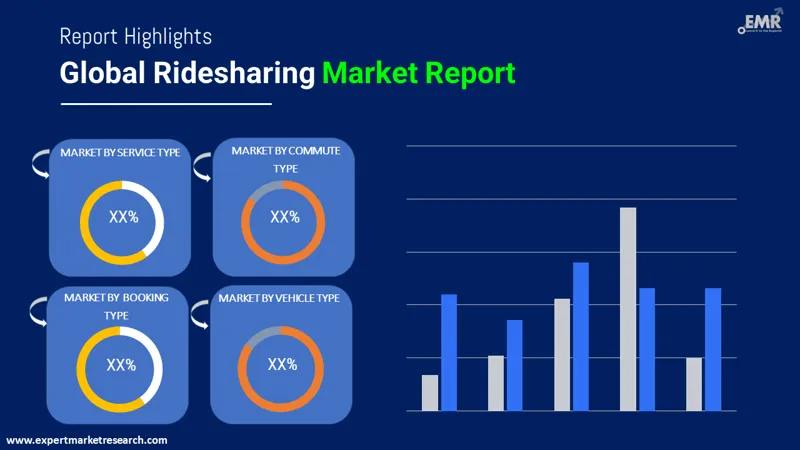
Consumer Insights
Uncover trends and behaviors shaping consumer choices today
Procurement Insights
Optimize your sourcing strategy with key market data
Industry Stats
Stay ahead with the latest trends and market analysis.
The global ridesharing market value is likely to expand at a CAGR of 16.80% during 2026-2035.
Base Year
Historical Period
Forecast Period
Compound Annual Growth Rate
16.8%
2026-2035
*this image is indicative*
| Global Ridesharing Market Report Summary | Description | Value |
| Base Year | USD Billion | 2025 |
| Historical Period | USD Billion | 2019-2025 |
| Forecast Period | USD Billion | 2026-2035 |
| Market Size 2025 | USD Billion | XX |
| Market Size 2035 | USD Billion | XX |
| CAGR 2019-2025 | Percentage | XX% |
| CAGR 2026-2035 | Percentage | 16.80% |
| CAGR 2026-2035 - Market by Region | North America | 17.1% |
| CAGR 2026-2035 - Market by Country | India | 20.1% |
| CAGR 2026-2035 - Market by Country | Canada | 19.6% |
| CAGR 2026-2035 - Market by Commute Type | Intracity | 18.3% |
| CAGR 2026-2035 - Market by Booking Type | Online Booking | 22.4% |
| Market Share by Country 2025 | France | 3.8% |
Growing population and expanding global industrialization have led to a boom in the ridesharing industry in recent years. Decreasing dependence on single-occupancy vehicles is considered a possible solution to relieving traffic congestion. The growth of the ridesharing market is driven by technological advancements, which have significantly increased its popularity.
Technological advancements are expected to drive the global ridesharing market even further. Modern apps have made it easier for travellers to get in touch with domestic carpools, and leading players such as Lyft and Uber have taken steps to capture the carpooling space, thus boosting the ridesharing market revenue.

Read more about this report - REQUEST FREE SAMPLE COPY IN PDF
Increasing smartphone penetration is likely to enhance the global ridesharing market demand. Tablets and smartphones have been growing in popularity among users falling under different age groups and types. Pricing, portability, easy and interactive access, and adaptability are some factors behind such popularity. Increasing fuel and car prices are also expected to boost ridesharing market growth.
According to the Federal Statistical Office, private motorized road transport increased by 15% from 2000, reaching 90.9 billion person-km in 2022. Within this category, passenger cars experienced a 14% rise since 2000, totalling 85.8 billion person-km (Department of Transport UK). Public road transport, including tramways, trolleybuses, and buses, surged by 23% from 2000, amounting to 4.2 billion person-km further enhancing the ridesharing demand growth.
Railways marked a significant 53% growth since 2000, with a performance of 19.3 billion person-km in 2022. Cog railways and cable cars saw a modest 12% increase from 2000, recording 0.4 billion per km. Active mobility, encompassing walking and cycling, rose by 20% from 2000, reaching 7.8 billion person-km.
In 2023, the number of licensed taxis and private hire vehicles (PHVs) per 1,000 people in England exhibited significant urban-rural disparities. According to data from the UK Government, London led with approximately 12 cars per 1,000 people, where licensed PHVs dominated this figure boosting the ridesharing industry revenue. In urban areas with major conurbations, the number dropped to about 4 cars per 1,000 people, with a noticeable proportion of licensed taxis and PHVs. Urban areas with minor conurbations and cities and towns followed closely, each maintaining around 3 vehicles per 1,000 people.
Similarly, the Hong Kong Transport Department states that as of 2024, taxis are a major supplier of public passenger transport services in the city. Currently, Hong Kong has 18,163 taxis, of which 15,250 are urban taxis (red), 2,838 are taxis from the New Territories (green), and 75 are taxis from Lantau (blue). There are almost one million taxi rides every day on average.
The ridesharing market is fiercely competitive, driven by technological innovation, sustainability commitments, and aggressive expansion strategies. Uber leads with its vast global reach and diversification into food delivery and freight. DiDi is a formidable competitor with strong technological advancements and rapid expansion in Latin America.
Lyft focuses on sustainability and strategic partnerships, while Ola leverages its dominant position in India and expands its international presence. Cabify maintains a stronghold in Spain and Latin America with a focus on sustainability and regional expertise. The market is characterised by continuous innovation, strategic expansions, and a growing emphasis on sustainability.
Uber Technologies Inc.
Expanded Uber Eats and introduced Uber Freight.
DiDi Global Inc.
Lyft, Inc.
ANI Technologies Private Limited (Ola)

Read more about this report - REQUEST FREE SAMPLE COPY IN PDF
“Global Ridesharing Market Report and Forecast 2026-2035” offers a detailed analysis of the market based on the following segments:
Market Breakup by Service Type
Market Breakup by Commute Type
Market Breakup by Booking Type
Market Breakup by Vehicle Type
Market Breakup by Region
| CAGR 2026-2035 - Market by | Country |
| India | 20.1% |
| Canada | 19.6% |
| China | 18.1% |
| UK | 17.5% |
| Saudi Arabia | 16.5% |
| USA | XX% |
| Germany | 15.7% |
| France | XX% |
| Italy | XX% |
| Japan | XX% |
| Australia | XX% |
| Brazil | XX% |
| Mexico | XX% |
E-hailing provides convenience, shorter wait times, cost efficiency, enhanced safety, cashless payments, and environmental benefits through carpooling, thereby boosting growth of the ridesharing industry. Station-based mobility enhances ridesharing with structured pick-up/drop-off points, predictability, cost savings, safety, improved fleet management, and integration with public transport for seamless multi-modal journeys.
The companies provides ride-hailing services across many cities globally, prioritizing safety, quality, innovation, and delivering convenient and reliable mobility solutions to its customer.




*While we strive to always give you current and accurate information, the numbers depicted on the website are indicative and may differ from the actual numbers in the main report. At Expert Market Research, we aim to bring you the latest insights and trends in the market. Using our analyses and forecasts, stakeholders can understand the market dynamics, navigate challenges, and capitalize on opportunities to make data-driven strategic decisions.*
Get in touch with us for a customized solution tailored to your unique requirements and save upto 35%!
The market is assessed to grow at a CAGR of 16.80% between 2026 and 2035.
The major market drivers are the growing tourism industry, preference of people to avoid ownership of vehicles, and an increasing population.
The key market trends include the interest of commuters in finding economical ways to travel, importance of being eco-friendly, and the rising penetration of the internet and smartphones, simplifying the process to book rides.
The market is broken down into North America, Europe, Asia Pacific, Latin America, the Middle East, and Africa.
The market is categorised according to the service type, which includes e-hailing and station-based mobility.
Based on the commute type, the market is divided into intercity and intracity.
Based on the booking type, the market is divided into offline booking and online booking.
Based on the vehicle type, the market is divided into cars, bike, scooters and others.
The market's key players are Uber Technologies Inc., DiDi Global Inc., Lyft, Inc., ANI Technologies Private Limited, and Cabify Spain SLU, among others.
Ridesharing aims to reduce negative impacts associated with emissions, lower traveling costs and congestion, increase passenger vehicle occupancy, and provide convenience to travellers.
Explore our key highlights of the report and gain a concise overview of key findings, trends, and actionable insights that will empower your strategic decisions.
| REPORT FEATURES | DETAILS |
| Base Year | 2025 |
| Historical Period | 2019-2025 |
| Forecast Period | 2026-2035 |
| Scope of the Report |
Historical and Forecast Trends, Industry Drivers and Constraints, Historical and Forecast Market Analysis by Segment:
|
| Breakup by Service Type |
|
| Breakup by Commute Type |
|
| Breakup by Booking Type |
|
| Breakup by Vehicle Type |
|
| Breakup by Region |
|
| Market Dynamics |
|
| Competitive Landscape |
|
| Companies Covered |
|
Datasheet
One User
USD 2,499
USD 2,249
tax inclusive*
Single User License
One User
USD 3,999
USD 3,599
tax inclusive*
Five User License
Five User
USD 4,999
USD 4,249
tax inclusive*
Corporate License
Unlimited Users
USD 5,999
USD 5,099
tax inclusive*
*Please note that the prices mentioned below are starting prices for each bundle type. Kindly contact our team for further details.*
Flash Bundle
Small Business Bundle
Growth Bundle
Enterprise Bundle
*Please note that the prices mentioned below are starting prices for each bundle type. Kindly contact our team for further details.*
Flash Bundle
Number of Reports: 3
20%
tax inclusive*
Small Business Bundle
Number of Reports: 5
25%
tax inclusive*
Growth Bundle
Number of Reports: 8
30%
tax inclusive*
Enterprise Bundle
Number of Reports: 10
35%
tax inclusive*
How To Order

Select License Type
Choose the right license for your needs and access rights.

Click on ‘Buy Now’
Add the report to your cart with one click and proceed to register.

Select Mode of Payment
Choose a payment option for a secure checkout. You will be redirected accordingly.
Gain insights to stay ahead and seize opportunities.

Get insights & trends for a competitive edge.

Track prices with detailed trend reports.

Analyse trade data for supply chain insights.

Leverage cost reports for smart savings

Enhance supply chain with partnerships.

Connect For More Information
Our expert team of analysts will offer full support and resolve any queries regarding the report, before and after the purchase.
Our expert team of analysts will offer full support and resolve any queries regarding the report, before and after the purchase.
We employ meticulous research methods, blending advanced analytics and expert insights to deliver accurate, actionable industry intelligence, staying ahead of competitors.
Our skilled analysts offer unparalleled competitive advantage with detailed insights on current and emerging markets, ensuring your strategic edge.
We offer an in-depth yet simplified presentation of industry insights and analysis to meet your specific requirements effectively.
Share